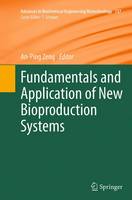


|
|
|
books
| book details |
Fundamentals and Application of New Bioproduction Systems
Edited by An-Ping Zeng

|
| on special |
normal price: R 6,985.95
Price: R 6,287.95
|
| book description |
Printing Peptide Arrays with a Complementary Metal Oxide Semiconductor Chip, by Felix F. Loeffler, Yun-Chien Cheng, Bastian Muenster, Jakob Striffler, Fanny C. Liu, F. Ralf Bischoff, Edgar Doersam, Frank Breitling, Alexander Nesterov-Mueller. Protein Engineering as a Tool for the Development of Novel Bio production Systems, by Uwe T. Bornscheuer. Compartmentalization and Metabolic Channeling for Multienzymatic Biosynthesis: Practical Strategies and Modeling Approaches, by U. Jandt, C. You, Y. H.-P. Zhang, A.-P. Zeng. Cell-Free Systems: Functional Modules for Synthetic and Chemical Biology, by Marlitt Stech, Andreas K. Brödel, Robert B. Quast, Rita Sachse, Stefan Kubick. New Bio production Systems: From Molecular Circuits to Novel Reactor Concepts in Cell-Free Biotechnology, by Steffen Rupp. Cell-free Biosystems in the Production of Electricity and Bioenergy, by Zhiguang Zhu, Tsz Kin Tam, Y.-H. Percival Zhang. In Vitro Multi enzymatic Reaction Systems for Biosynthesis, by Inés Ardao, Ee Taek Hwang, An-Ping Zeng. Directed Multistep Biocatalysis Using Tailored Permeabilized Cells, by Steffen Krauser, Christian Weyler, Lisa Katharina Blaß, Elmar Heinzle.
| product details |

Normally shipped |
Publisher | Springer-Verlag Berlin and Heidelberg GmbH & Co. KG
Published date | 23 Aug 2016
Language |
Format | Paperback / softback
Pages | 238
Dimensions | 235 x 155 x 0mm (L x W x H)
Weight | 0g
ISBN | 978-3-6625-1100-8
Readership Age |
BISAC | science / biotechnology
| other options |
|
|
|
To view the items in your trolley please sign in.
| sign in |
|
|
|
| specials |
|
|
Let's stare the future down and, instead of fearing AI, become solutionists.
|
This first comprehensive biography of Cecil Rhodes in a generation illuminates Rhodes’s vision for the expansion of imperialism in southern Africa, connecting politics and industry to internal development, and examines how this fueled a lasting, white-dominated colonial society.
|
|
|
|
|